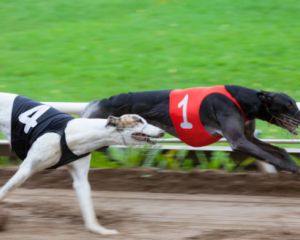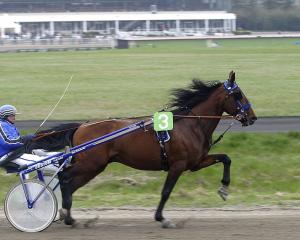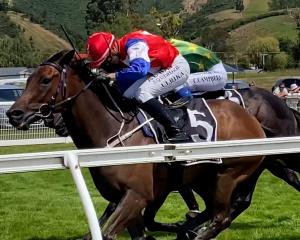
At 5.45am, Courtney Barnes’ alarm goes off. Soon she will head to White Robe Lodge, the stables of
thoroughbred trainers Brian Anderton and son Shane. The 23-year-old has been working there since she was 17, a time when she was a young, fresh-faced kid —
when, as she describes it, she was barely able to hang on to a horse.
Barnes had some previous experience riding horses and enjoyed it and so decided to explore it as a career path. It is a wise move, as soon she will develop into a feature race-winning senior rider, earning her living from the craft.
The stables are a hive of activity as preparations start on working the big team of horses in training.
Six days a week, Barnes will ride horses at speeds of more up to 65kmh around Wingatui racecourse and at the White Robe Lodge property, with only two stirrup irons attached to the saddle to hold her on board while she steers the 550kg athlete via its reins.
Barnes will spend up to three hours riding one horse then another, in tandem with with up to five jockeys and their mounts from the stable. But the work does not stop once the racehorses have been out. Younger and emerging horses are put through their paces next as part of their education. Then there are loose boxes to be cleaned, horses to be fed and gear to be organised.
When Barnes’ work is done at White Robe Lodge, she heads straight to the gym.
Jockeys require a unique kind of fitness that is hard to describe, she says.
The riders need to be aerobically fit in order to urge their horses along in the finish of a race, but they also have to have strength that defies their size. Their arms have to be strong enough to control mounts 10 times their own weight, and their legs need to hold their balance perfectly at top speed.
Although she says riding horses is the best kind way to improve her fitness, Barnes complements that by putting herself through an intense and varied workout routine. Once that is finished, she will pick up her phone if it is the middle of the week. Jockeys need to be booked to ride horses three or four days out from a race meeting. That means she will be on the phone to the trainers of her regular rides, and they may also call her to confirm her availability.
She will also scan the race fields looking for opportunities to ride horses who may not have a jockey confirmed or whose jockey is unavailable.
In the afternoon, on quieter days on which there are no races, Barnes will have the rest of the afternoon to herself.
Her passion for horses means spending some of that time riding her hack, though the relaxed nature of that ride is completely different from riding a horse in training or in a race, she says.
On race days her afternoons are far from tranquil. Those days involve a lengthy car trip as far south as Invercargill or as far north as Christchurch.
On the way to the races, Barnes will try to relax rather than running the races over in her head too much, because that work has been done the night before. She will have spent hours trawling through race videos analysing not only some of the traits of her own horses, but her opposition’s, too. That involves studying which horses might be positioned where in each race, how the speed of the race will be affected and which horses will be better to follow than others.
From there, the jockey will develop a rough plan on where she wants to position her horse in the race.
Although she has a thorough tactical grasp on the race by then, Barnes will be given instructions before each race. Trainers and sometimes owners will offer their thoughts on where the horse should be positioned and how she should ride her race before she jumps aboard.
Before that, though, the jockey will arrive on course and unpack her gear and get ready for the first race.
Her lead-up to the first race differs considerably to that of many of her fellow riders. Jockeys who ride on the flat are generally required to ride at weights between 60kg and 54kg, something that comes reasonably easily to Barnes who is naturally 51kg.
That means she can eat relatively normally leading into a race meeting when some of her counterparts are restricted to eating one small, lean meal and then nothing on the day of the race in order to keep their weight down. Any excess they are still carrying will need to be sweated out in the racecourse sauna before their first ride.
Once Barnes has weighed out with her saddle and put her racing colours on, hours and hours of training, travelling, form study and phone calls come down to a minute or two — depending on the distance of the race.
After she jumps her horse out of the starting barriers and positions it in the best place she can, excitement and anticipation build. She analyses who is in front of her, what those runners are doing and what moves they could make, and how that could affect the moves she will make.
All of that can change in a split second with Barnes having to react just as quickly to keep her horse in the best possible and safest position.
A thousand things can go right or wrong during a race — tactically, and depending on how the horse handles the weather and track conditions or even the mood it is in.
But when things go right and the horse launches a winning run there no feeling like it, Barnes says.
It is hard to describe, but the adrenaline is pumping through her veins.
Last year she got her ultimate thrill in the saddle when riding Coulee to win the group 3 $70,000 White Robe Lodge Handicap at Wingatui.
Though there can be many winning days there are even more when luck does not go a jockey’s way. However, walking away from any race day — even one when the horses finish closer to last than first — is a good day.
Barnes and her fellow southern jockeys have days when they experience pain that few other occupations can bring. Falling off or having your horse fall after contact with another runner is part of the racing game. Though it happens rarely, it is a constant danger — and lives have been lost.
Two of Barnes’ friends have died from race falls. In 2012, Ashlee Mundy died after a race fall at Kurow and last November, Rebecca Black died from a race fall at Gore.
Those tragedies gave Barnes a big fright at the time, but there are ways you have to look at life that make you want to carry on riding, she says.
Once the races are finished, no matter the results, she will head home with adrenaline still pumping. If it has been a really good day, there might be a few celebratory drinks but if the results do not go her way she tries to turn to the page quickly.
Race-riding is a confidence sport; dwelling on what could have been will not help.
After getting home and greeting her partner, Hagan Leiataua, it can be difficult to relax and winding down after a race meeting does take time. But eventually bed will call, another day in the life of a jockey is over, and Barnes will need her rest because she will do it all again tomorrow.
















